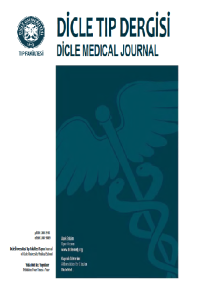Abstract
Amaç: Dünyada pandeminin sürdüğü esnada COVID-19’in uzun süreli etkileri rapor edilmeye başlandı ve 12 haftadan uzun süren olgular uzun-covid sendromu olarak ifade edildi. Uzun covid sendromunun en belirgin ifadesi sinir sistemi üzerine gösterdiği belirtilerdi. Bu etkiler uzun covid sendromuna bağlı “beyin sisi” olarak adlandırıldı. Biz de bu çalışma da COVID-19 geçirmiş bireylerde nörokognitif etkileri denetlemeyi amaçladık.
Yöntemler: Bu amaçla benzer yaş grubuna sahip, tanı aldıkları tarihten 12 hafta geçmiş COVID-19 geçiren 36 katılımcı yanı sıra COVID-19 tanısı almamış 35 birey çalışmaya dahil edildi. Bu çalışmada Simon etkisi olarak adlandırılan yönelim etkisinin test edilebilmesi için hazırlanmış işitsel bir görev katılımcılara uygulandı. Eş zamanlı olarak EEG kayıtları alındı. Görev esnasında tüm katılımcıların kayıtları üzerinde olay ilişkili potansiyel kayıtları alındı.
Bulgular: Çalışmanın davranış sonuçlarında gruplar arası test başarı oranı arasında fark yoktu. Fakat covid grubu kontrol grubuna göre görev tamamlama ve reaksiyon sürelerinde artış gözlendi. Olay ilişkili potansiyel kayıtlarında uyumlu uyaran sunumunda neredeyse tüm dalga amplitüd ve latansları iki grup için benzerdi. Bunun aksine uyumsuz uyaran sunumunda gruplar arasından N2 amplitüd ve latansları bakımından anlamlı fark gözlendi. Bununla birlikte covid grubu P3 Δt kontrol grubuna göre artmıştı. Çalışma sonuçlarımızda gözlenen covid grubundaki reaksiyon süresi artışı elektrofizyolojik ölçümlerde de doğrulandı.
Sonuç: Bulgular COVID-19’un dikkatin oluşumu ve uyarana karşın cevap hazırlığı esnasında inhibitör işlemin azaldığını. COVID-19’a bağlı yaşanan beyin sisinin dikkatin ön işlem basamaklarında meydana geldiğini gösterdi.
References
- 1.Katella K. What to Know About EG.5 (Eris)—theLatest Coronavirus Strain Yale medicine: Yalemedicine; 2023. Ulaşılabileceği adres:https://www.yalemedicine.org/news/covid-eg5-eris-latest-coronavirus-strain.
- 2.Krishnan K, Lin Y, Prewitt KM, Potter DA.Multidisciplinary Approach to Brain Fog and RelatedPersisting Symptoms Post COVID-19. J Health ServPsychol. 2022;48(1):31-8.
- 3.NHS. Long-term effects of COVID-19 (long COVID):NHS; 2023 [Ulaşabileceği adres:https://www.nhs.uk/conditions/covid-19/long-term-effects-of-covid-19-long-covid/.
- 4.Hugon J, Msika E-F, Queneau M, Farid K, Paquet C.Long COVID: cognitive complaints (brain fog) anddysfunction of the cingulate cortex. Journal ofNeurology. 2022;269(1):44-6.
- 5.Nasserie T, Hittle M, Goodman SN. Assessment of the Frequency and Variety of Persistent Symptoms AmongPatients With COVID-19: A Systematic Review. JAMANetw Open. 2021;4(5):e2111417.
- 6.Yang AC, Kern F, Losada PM, et al. Dysregulation ofbrain and choroid plexus cell types in severe COVID-19.Nature. 2021;595(7868):565-71.
- 7.de Erausquin GA, Snyder H, Carrillo M, et al. Thechronic neuropsychiatric sequelae of COVID-19: Theneed for a prospective study of viral impact on brainfunctioning. Alzheimers Dement. 2021;17(6):1056-65.
- 8.Paterson RW, Brown RL, Benjamin L, et al. Theemerging spectrum of COVID-19 neurology: clinical,radiological and laboratory findings. Brain.2020;143(10):3104-20.
- 9.Sanabria-Diaz G, Etter MM, Melie-Garcia L, Lieb JM,Psychogios MN, Hutter G, et al. Brain corticalalterations in COVID-19 patients with neurologicalsymptoms. Front Neurosci. 2022;16:992165.
- 10.McCall S, Vilensky JA, Gilman S, Taubenberger JK.The relationship between encephalitis lethargica andinfluenza: a critical analysis. J Neurovirol.2008;14(3):177-85.
- 11. Cairns DM, Rouleau N, Parker RN, et al. A 3D human brain-like tissue model of herpes-induced Alzheimer'sdisease. Sci Adv. 2020;6(19):eaay 8828.
- 12.Buzhdygan TP, DeOre BJ, Baldwin-Leclair A,Bullock TA, McGary HM, Khan JA, et al. The SARS-CoV-2 spike protein alters barrier function in 2D static and3D microfluidic in-vitro models of the human blood-brain barrier. Neurobiol Dis. 2020;146:105131.
- 13.Becker JH, Lin JJ, Doernberg M, Stone K, Navis A,Festa JR, et al. Assessment of Cognitive Function inPatients After COVID-19 Infection. JAMA Netw Open.2021;4(10):e2130645.
- 14.Oldfield RC. The assessment and analysis ofhandedness: the Edinburgh inventory.Neuropsychologia. 1971;9(1):97-113.
- 15.Simon JR. Reactions toward the source ofstimulation. J Exp Psychol. 1969;81(1):174-6.
- 16.Cespon J, Hommel B, Korsch M, Galashan D. Theneurocognitive underpinnings of the Simon effect: Anintegrative review of current research. Cogn Affect Behav Neurosci. 2020;20(6):1133-72.
- 17.Hommel B. Attention and spatial stimulus coding inthe Simon task: A rejoinder to van der Lubbe andAbrahamse (2010). Acta psychologica. 2010;136:265-8.
- 18.Leuthold H. The Simon effect in cognitiveelectrophysiology: A short review. Acta psychologica.2011;136(2):203-11.
- 19.Helfrich RF, Knight RT. Cognitive neurophysiology:Event-related potentials. Handbook of clinicalneurology. 2019;160:543-58.
- 20.Sutton S, Braren M, Zubin J, John ER. Evoked-potential correlates of stimulus uncertainty. Science(New York, NY). 1965;150(3700):1187-8.
- 21.Köse A, Uysal HT, Parlak MM, et al. TheInvestigation of the Cognitive CommunicationFunctions of Survivours of Coronavirus Disease 2019(COVID-19): A Survey Study. Karya Journal of HealthScience. 2022;3(3):338-42.
- 22. Öztürk Ü, Tamam Y. COVID-19 ve Nöroloji. Dicle Tıp Dergisi. 2021;48:49-54.
- 23.Stürmer B, Leuthold H, Soetens E, Schröter H,Sommer W. Control over location-based responseactivation in the Simon task: behavioral andelectrophysiological evidence. Journal of experimentalpsychology Human perception and performance.2002;28(6):1345-63.
- 24.Wühr P. Evidence for gating of direct responseactivation in the Simon task. Psychon Bull Rev.2005;12(2):282-8.
- 25.Zhang X, Wang Y, Li S, Wang L. Event-relatedpotential N270, a negative component to identificationof conflicting information following memory retrieval.Clinical neurophysiology: official journal of theInternational Federation of Clinical Neurophysiology.2004;114:2461-8.
- 26.Folstein JR, Van Petten C. Influence of cognitivecontrol and mismatch on the N2 component of the ERP:a review. Psychophysiology. 2008;45(1):152-70.
- 27.Yeung N, Botvinick MM, Cohen JD. The neural basisof error detection: conflict monitoring and the error-related negativity. Psychol Rev. 2004;111(4):931-59.
- 28.van Veen V, Carter CS. The anterior cingulate as aconflict monitor: fMRI and ERP studies. Physiology &behavior. 2002;77(4-5):477-82.
Details
| Primary Language | Turkish |
|---|---|
| Subjects | Health Care Administration, Medical Education |
| Journal Section | Research Article |
| Authors | |
| Publication Date | June 14, 2024 |
| Submission Date | March 13, 2024 |
| Acceptance Date | June 7, 2024 |
| Published in Issue | Year 2024 Volume: 51 Issue: 2 |

